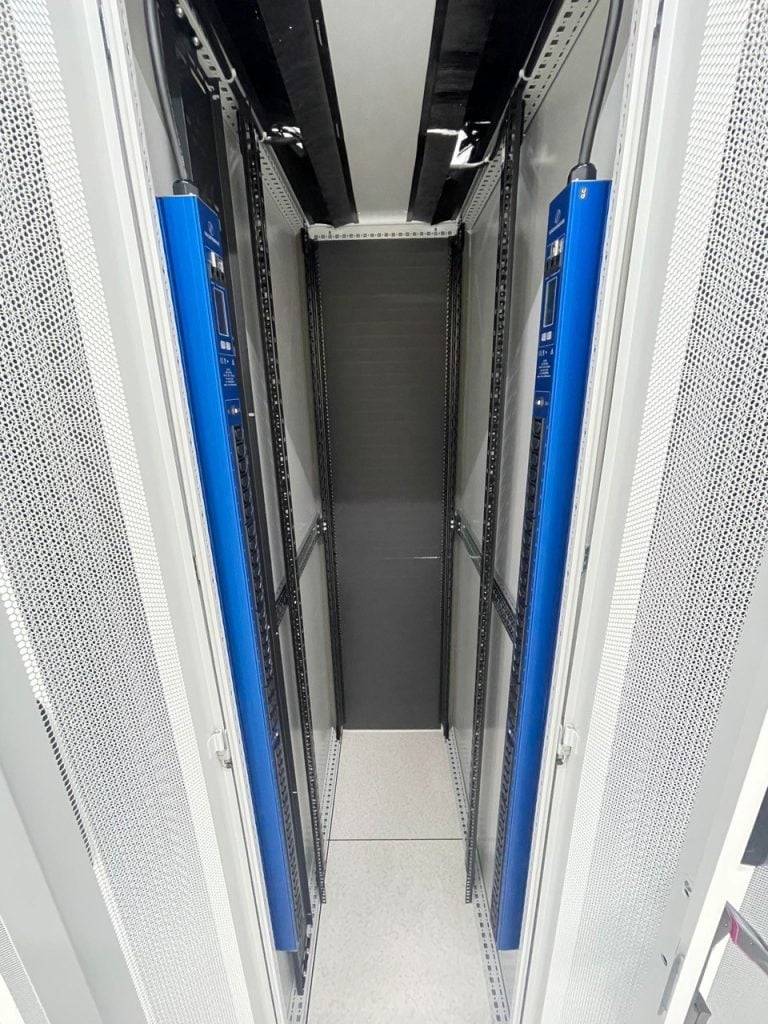As digital transformation accelerates, the lifecycle of data centers is shrinking, hence the introuduction of data center decommissioning services. Studies show that outdated data centers can cost businesses up to 20% more in energy consumption alone, not to mention the mounting risk of data breaches.
Data center decommissioning, therefore, isn’t merely about dismantling servers—it’s a crucial, carefully planned process to retire IT assets while protecting sensitive data and adhering to environmental standards.
Beyond handling hardware, decommissioning ensures compliance, mitigates risk, and supports responsible e-waste disposal.
In this data center decommissioning blog, we’ll walk through the essentials of decommissioning, from checklists to secure data handling, so you can navigate this complex process smoothly.
Why Is Data Center Decommissioning Necessary?
Data Center Decommissioning is essential for organizations looking to manage technology upgrades while protecting sensitive information. As technology evolves, even the most advanced data centers can become outdated, inefficient, and costly to maintain.
Decommissioning an obsolete data center provides multiple benefits that contribute to both security and compliance.
Key Reasons for Data Center Decommissioning
- Optimize Resources
Decommissioning a data center frees up valuable physical space, which can be repurposed for modern IT infrastructure or new projects. Reallocating resources also allows companies to focus on cutting-edge technology and enhance operational efficiency.
- Enhance Security
Old systems can be vulnerable to unauthorized access and data breaches. By decommissioning outdated systems, organizations minimize these risks and prevent confidential data from falling into the wrong hands.
- Reduce Environmental Impact
Proper disposal of e-waste is a key component of any data center decommissioning checklist. Recycling or responsibly discarding end-of-life hardware minimizes environmental harm. Following R2 standards or similar practices for e-waste handling also supports sustainability goals.
- Ensure Compliance
Regulations like GDPR and HIPAA impose strict rules on data handling and disposal. Data center decommissioning ensures compliance with these data protection laws, reducing the risk of penalties associated with improper data disposal.
Risks of Neglecting Data Center Decommissioning
- Data Breaches: Old hardware can retain sensitive data, making it vulnerable to theft.
- Regulatory Penalties: Non-compliance with data disposal regulations can result in costly fines.
- Higher Operational Costs: Keeping obsolete equipment leads to inefficiencies, driving up power and maintenance costs.
Incorporating a data center decommissioning checklist helps manage these risks effectively, ensuring a streamlined and secure transition away from outdated infrastructure. This careful approach to decommissioning is not only a cost-effective decision but a strategic one, safeguarding both data security and regulatory compliance.
Also Read: Data Center Decommissioning: A Comprehensive Guide to Shutting Down and Upgrading Facilities
Key Steps in Data Center Decommissioning
1. Creating a Comprehensive Data Center Decommissioning Checklist
A data center decommissioning checklist is essential for smooth operation. The checklist ensures that each step is followed precisely, preventing any component from being overlooked. Here’s what a basic data center decommissioning checklist should include:
- Asset Inventory: List and categorize all equipment, including servers, network devices, and storage systems.
- Data Backup: Ensure all data is securely backed up before decommissioning starts.
- Data Destruction: Identify methods for data wiping or destruction, ensuring no sensitive information is left behind.
- Hardware Removal: Plan for the safe removal of equipment and cables.
- Environmental Compliance: Ensure proper disposal of e-waste according to regulations.
In larger companies, this inventory can be challenging due to multiple devices and software licenses. Smaller companies, with fewer assets, often find it easier to manage. Still, no matter the size of the data center, every organization should prioritize creating a comprehensive checklist.
2. Mapping Dependencies in Your Data Center
Data centers consist of interconnected servers, network devices, and software applications. Understanding dependencies is crucial for smooth decommissioning. Dependency mapping involves identifying which applications rely on specific servers and network resources.
Why Dependency Mapping Matters
- Avoid Downtime: Prevent disruptions by shutting down interconnected applications gradually.
- Mitigate Risks: Ensure applications dependent on decommissioned servers continue to function.
- Cost Control: Avoid unexpected expenses from disruptions by anticipating dependency issues.
3. Partnering with a Reliable Data Center Decommissioning Service Provider
Data center decommissioning is complex and requires experienced professionals. Although some in-house IT teams may handle smaller projects, larger decommissioning efforts are best managed by a specialized data center decommissioning company.
When Choosing a Provider
- Experience and Track Record: Look for a company with proven expertise in data center decommissioning.
- Transparency: Ensure clear communication and a detailed statement of work (SOW).
- Environmental Responsibility: Confirm the provider follows e-waste recycling standards like the R2 Standard.
- Data Security: Verify that the provider has protocols for secure data destruction.
Professional providers offer structured decommissioning plans, risk assessment, and experienced personnel, streamlining the process for minimal disruption.
4. Ensuring Responsible Recycling of Electronic Equipment
Data center decommissioning produces significant amounts of electronic waste, including servers, batteries, and cooling systems. Responsible e-waste recycling protects the environment and reduces legal risks.
Guidelines for Responsible Recycling
- Follow the R2 Standard: This certification ensures safe disposal, recovery, or reuse of electronic components.
- Track Chain of Custody: Monitor every piece of equipment from removal to recycling, ensuring transparency.
- Separate Toxic Materials: Identify and properly handle hazardous substances like lead, mercury, and cadmium.
5. Prioritizing Security During the Decommissioning Process
Security is a priority during decommissioning, especially when dealing with sensitive data. A secure process minimizes the risk of unauthorized access and protects valuable information.
Best Practices for Data Security
- On-Site Data Destruction: Destroy data at your facility before transporting equipment.
- Controlled Access: Limit data center access to authorized personnel only.
- Staff Verification: Verify IDs and track personnel involved in decommissioning tasks.
- Video Surveillance: Monitor all activities within the data center for added security.
By implementing these measures, organizations protect sensitive information and ensure compliance with data privacy regulations.
Also Read: Hard Drive Shredding Secrets: How You’re Losing Data and What to Do About It
Case Study: Successful Data Center Decommissioning
A large financial institution in Orange County, CA, faced the challenge of data center decommissioning while safeguarding confidential client information. Partnering with a professional team specializing in data center decommissioning in Orange County, CA, they:
- Created a detailed decommissioning checklist covering data backup, asset inventory, and data destruction.
- Mapped dependencies to ensure seamless migration of applications to a new facility.
- Implemented on-site data destruction for all sensitive data, ensuring full compliance with regulatory requirements.
- Utilized the R2 Standard for environmentally responsible recycling.
The decommissioning process was completed successfully, reducing overhead costs and enhancing data security.
Data Center Decommissioning Checklist
Decommissioning a data center requires meticulous planning and execution to safeguard data, optimize resources, and adhere to environmental standards. Below is a checklist to ensure a comprehensive and secure decommissioning process.
Essential Steps in Data Center Decommissioning Checklist
- Asset Inventory
Begin by cataloging all assets in the data center, including servers, storage devices, and networking equipment. This detailed inventory should document:
- Location and condition of each item
- Identification of equipment containing sensitive data
- Equipment intended for repurposing, recycling, or disposal
An accurate inventory supports efficient decommissioning and minimizes the risk of overlooking critical components.
- Data Backup
Before decommissioning any equipment, back up all essential data to prevent potential loss and ensure business continuity. Data backup options include:
- Offsite storage solutions
- Cloud-based backup
- Secure transfer to alternative locations
Ensuring data integrity through backups provides protection and readiness for unexpected decommissioning issues.
- Data Destruction
Once data is backed up, securely destroy it on all storage devices to prevent unauthorized access. Consider these methods:
- Data wiping and degaussing for secure deletion
- Physical destruction for sensitive data
Adhere to industry standards (e.g., NIST or DoD) for data disposal, particularly in regulated industries where compliance is critical.
- Hardware Removal
Carefully remove hardware from the facility, coordinating with IT, facilities management, and logistics teams to streamline the process. Key practices include:
- Proper labeling and handling to prevent damage
- Safe packing for transportation if relocating equipment
Ensure hardware removal follows best practices for either reuse, recycling, or secure disposal.
- Environmental Compliance
Responsible e-waste disposal is critical to protect the environment. Follow R2 Standards or equivalent environmental guidelines, focusing on:
- Safe disposal of electronic components
- Partnering with certified recyclers
Environmental compliance safeguards your organization’s reputation and demonstrates a commitment to sustainability.
- Security Measures
Throughout the decommissioning process, maintain strict security controls. Important security measures include:
- Restricting facility access to authorized personnel
- Implementing on-site data destruction
- Monitoring personnel with badges or biometric access
If relocating equipment, use secure transport services to prevent any risk to data security.
Data Center Decommissioning Checklist
| Step | Description |
| Asset Inventory | List and document all equipment and locations. |
| Data Backup | Back up all data before decommissioning. |
| Data Destruction | Wipe or destroy data on storage devices. |
| Hardware Removal | Remove equipment safely and prepare for disposal. |
| Environmental Compliance | Ensure recycling meets R2 Standards. |
| Security Measures | Restrict access, implement on-site data destruction. |
Following this checklist ensures a secure, efficient, and environmentally responsible data center decommissioning, protecting your organization from data breaches and regulatory penalties.
Also Read: Top Hack: Master IT Infrastructure Management & Supercharge Your Business Growth
Regional Market Insights for Data Center Decommissioning
Data center decommissioning varies significantly by region, influenced by local industries, regulations, and business demands. Let’s explore how decommissioning needs differ across some of the most active data center markets in the U.S.
Data Center Decommissioning in Houston
Houston has emerged as a key player in the data center industry due to its strategic location and strong energy sector. Many companies in Houston, particularly those in oil, gas, and other energy sectors, require robust data center decommissioning solutions as they upgrade facilities or consolidate operations. Key considerations for data center decommissioning in Houston include:
- Regulatory Compliance: Texas mandates strict guidelines for data destruction and e-waste disposal to minimize environmental impact.
- Energy Efficiency: As companies update equipment, they aim to optimize energy usage and streamline resources.
- Data Security: Sensitive information from Houston’s energy and financial sectors demands thorough data wiping and destruction.
Houston’s unique market conditions create a high demand for decommissioning services that can handle secure data destruction and adhere to environmental regulations.
Data Center Decommissioning in New York
New York’s business ecosystem, especially in finance, healthcare, and technology, places a high premium on data security and regulatory compliance. The data center decommissioning market in New York is characterized by:
- Data Security: Financial and healthcare institutions prioritize secure data wiping to meet HIPAA and financial regulations.
- Transparent E-Waste Disposal: New York State regulations require companies to document e-waste disposal and recycling processes.
- Compliance with Strict Regulations: Businesses must follow state laws that outline strict protocols for secure data handling and disposal.
New York’s emphasis on regulatory compliance makes it essential for decommissioning services to focus on secure data disposal, ensuring that companies can transition without risking data breaches or fines.
Our Data Center Decommissioning service ensures secure, efficient removal and disposal. Start your worry-free transition today! Explore Our Service
Data Center Decommissioning NJ
New Jersey’s data center decommissioning market is largely driven by growth in e-commerce and logistics sectors. Companies in these industries often relocate or expand, necessitating data center decommissioning solutions that prioritize both efficiency and security. Key factors include:
- Efficient Relocation: Fast-growing e-commerce businesses need efficient decommissioning for quick data center upgrades.
- Enhanced Security Protocols: Logistics and e-commerce companies focus on secure data handling to protect customer and operational data.
- Cost-Effective Solutions: Companies often seek decommissioning services that offer affordability without compromising on safety.
The demand for data center decommissioning in NJ reflects the region’s dynamic business growth, especially in industries where secure data handling and upgrades are vital for expansion.
Data Center Decommissioning in Orange County, CA
Orange County, California, boasts a growing technology sector, which has led to increased demand for data center decommissioning. Tech and other forward-facing businesses in this region focus on sustainable practices and advanced data security. Important trends in Orange County’s decommissioning market include:
- Asset Recovery: Many businesses prioritize asset recovery to offset costs by selling or repurposing equipment.
- Environmental Compliance: California has stringent environmental regulations for e-waste disposal, requiring sustainable recycling methods.
- Data Destruction: Secure data destruction is essential to meet compliance with California’s privacy laws and industry standards.
In Orange County, businesses require specialized decommissioning services that can handle asset recovery and ensure compliance with California’s environmental and data privacy laws.
Data Center Decommissioning Jobs and Salaries
Data center decommissioning requires skilled professionals for tasks like hardware dismantling, data destruction, and compliance monitoring. Demand for these roles is high, especially in tech hubs. For instance, positions involving data center decommissioning at Amazon are both competitive and well-compensated, reflecting the need for expertise in secure data handling and asset management.
Here’s a snapshot of job roles and their average salaries at leading companies, including Amazon, where the data center decommissioning salary can attract top talent to meet the complexities of decommissioning projects.
- Decommissioning Technician: Average Salary – $55,000 annually.
- Data Center Engineer: Average Salary – $90,000 annually.
- Decommissioning Project Manager: Average Salary – $115,000 annually.
These roles offer competitive salaries due to the specialized skills and meticulous attention required for secure and compliant data center decommissioning.
Frequently Asked Questions (FAQs)
What is Data Center Decommissioning?
Data center decommissioning is the process of shutting down, dismantling, and disposing of data center infrastructure while ensuring data security and regulatory compliance.
Why Is Data Center Decommissioning Necessary?
Decommissioning is essential for disposing of outdated equipment, optimizing space, and protecting data. It also helps meet environmental regulations through responsible recycling.
What is a Data Center Decommissioning Checklist?
A decommissioning checklist outlines the steps for asset inventory, data backup, data destruction, hardware removal, and security, ensuring a smooth and secure decommissioning process.
How Does Data Center Decommissioning Differ in Houston, New York, and Orange County, CA?
Regional requirements vary, with Houston focusing on energy efficiency, New York on data security, and Orange County on tech compliance. Each location tailors decommissioning services to local regulations.
What Skills are Needed for Data Center Decommissioning Jobs?
Data center decommissioning roles require technical skills in IT infrastructure, data destruction, asset inventory, and regulatory compliance, along with experience in secure data handling.
How Do Companies Ensure Secure Data Destruction?
Many companies use on-site data destruction methods like data wiping or physical destruction to prevent unauthorized access. Controlled access and surveillance enhance security.
Also Read: Data Migration: A Comprehensive Guide for Seamless Transition
Reboot Monkey: Streamline Your Data Center Decommissioning with Experts
Reboot Monkey is a trusted provider of comprehensive data center solutions, including secure, and efficient data center decommissioning services. We ensure that each project—from asset inventory to data destruction and equipment removal—is handled with precision, security, and environmental compliance.
Our experienced team is dedicated to minimizing downtime and maximizing security during the decommissioning process, following strict industry standards to safeguard data and responsibly manage e-waste.
With Reboot Monkey, you get a partner focused on smooth transitions, tailored solutions, and seamless support to keep your data center operations reliable and resilient.
Conclusion
Data center decommissioning is crucial for any organization planning to retire outdated IT infrastructure securely. This complex process involves safeguarding data, ensuring regulatory compliance, and responsibly recycling e-waste. Choosing a reputable data center decommissioning company simplifies the process, reduces risks, and ensures all components are handled professionally.
Planning each phase, from creating a data center decommissioning checklist to partnering with experienced professionals, allows for seamless decommissioning and minimal disruptions.
Ready to take the first step toward secure and efficient decommissioning? Contact Reboot Monkey for expert data center decommissioning services tailored to your organization’s unique needs.



